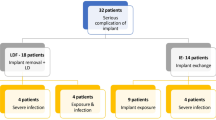Abstract
Background
Fingertip amputations are common injuries of the hand and their surgical treatment can be challenging due to their unique structure, composite content, and scarcity of available tissue. We describe the double wing transposition flap, a new technique for fingertip reconstruction, and report 1-year outcomes.
Methods
This is a retrospective study of patients who underwent a double wing transposition flap for fingertip reconstruction following amputation. Data with regards to the injured digit, size of the defect, level of amputation (Ishikawa), and plane of amputation was recorded. Any early complications of surgery were documented. The outcomes measured included time to return to work/ normal activities, the arc of motion at the distal interphalangeal joint (DIPJ), two-point discrimination (2-PD), and late complications like cold intolerance, pain, and nail deformity.
Results
A total of 46 patients (mean age: 28 years; 38 men and 8 women) with 46 fingertip amputations were reconstructed with a double wing transposition flap. The mean defect size was 2.2 × 1.9 cm. There were no partial or total flap losses. The mean arc of motion at the DIPJ was 73°, and the mean 2-PD was 4.8 mm. A total of 8 patients had a hook nail deformity. No patient complained of pain or cold intolerance.
Conclusions
The double wing transposition flap is a simple procedure for fingertip reconstruction. It can be done relatively fast, which does not need dissection of the neurovascular pedicles, and can be used in the reconstruction of transverse, volar oblique, and dorsal oblique fingertip amputations.
Level of evidence: Level IV, Therapeutic study.




Similar content being viewed by others
References
Clark DP, Scott RN, Anderson IW (1985) Hand problems in an accident and emergency department. J Hand Surg Br 10:297–299
De Alwis W (2006) Fingertip injuries. Emerg Med Australas 18:229–237
Tsai TM, Yuen CJ (1996) A neurovascular island flap for volar-oblique fingertip amputations: analysis of long-term results. J Hand Surg Br 21(1):94–98
Littler JW (1953) The neurovascular pedicle method of digital transposition for reconstruction of the hand. Plast Reconstr Surg 12(5):303–319
Pelissier P, Genin-Etcheberry T, Casoli V, Pistre V, Martin D, Baudet J (2001) Limits and indications of the dorsal transposition flap: critical evaluation of 15 cases. J Hand Surg Am 26(2):277–282
Chang SC, Chen SL, Chen TM, Chuang CJ, Cheng TY, Wang HJ (2004) Sensate first dorsal metacarpal artery flap for resurfacing extensive pulp defects of the thumb. Ann Plast Surg 53(5):449–454
Atasoy E, Iokimidis E, Kasdan ML, Kutz JE, Kleinert HE (1970) Reconstruction of the amputated finger tip with a triangular volar flap: a new surgical procedure. J Bone Joint Surg Am 52(5):921–926
Kutler WA (1947) A new method for fingertip amputation. J Am Med Assoc 133(1):29
Moberg E (1964) Aspects of sensation in reconstructive surgery of the upper extremity. J Bone Joint Surg Am 46:817–825
Snow JW (1967) The use of a volar flap for repair of fingertip amputations: a preliminary report. Plast Reconstr Surg 40(2):163–168
Lundborg G, Rosén B (2004) The two-point discrimination test–time for a re-appraisal? J Hand Surg Br 29(5):418–422
Zook EG (2003) Anatomy and physiology of the perionychium. Clin Anat 16(1):1–8
Tranquilli-Leali E (1935) Ricostruzione dell’apice delle falangi ungueali mediante autoplastica volare peduncolata per scorrimento. Infort Traumatol Lav 1:186–193
Segmüller G (1976) Modification of the Kutler flap: neurovascular pedicle [in German]. Handchirurgie 8(2):75–76
Venkataswami R, Subramanian N (1980) Oblique triangular flap: a new method of repair for oblique amputations of the fingertip and thumb. Plast Reconstr Surg 66(2):296–300
Tang JB, Elliot D, Adani R, Saint-Cyr M, Stang F (2014) Repair and reconstruction of thumb and finger tip injuries: a global view. Clin Plast Surg 41(3):325–359
Adani R, Busa R, Castagnetti C, Bathia A, Caroli A (1997) Homodigital neurovascular island flaps with “direct flow” vascularization. Ann Plast Surg 38(1):36–40
Macht SD, Watson HK (1980) The Moberg volar advancement flap for digital reconstruction. J Hand Surg Am 5(4):372–376
Ishikawa K, Ogawa Y, Soeda H, Yoshida Y (1990) A new classification of the amputation level for the distal part of the finger. J Jpn Soc Microsurg 3:54–62
Funding
The author declares that no funds, grants, or other support were received during the preparation of this manuscript.
Author information
Authors and Affiliations
Corresponding author
Ethics declarations
Conflict of interest
The author has no relevant financial or non-financial interests to disclose.
Patient consent
Patient consent was obtained from study participants.
Ethical Approval
All procedures performed in studies involving human participants were in accordance with the ethical standards of the institutional and/or national research committee and with the 1964 Helsinki Declaration and its later amendments or comparable ethical standards. Due the retrospective nature of the study, it was exempted from ethical approval by The Human Investigation Committee (IRB) of Adimayan University Faculty of Medicine (Doc. No: E-53911808-903-2698).
Additional information
Publisher's note
Springer Nature remains neutral with regard to jurisdictional claims in published maps and institutional affiliations.
Rights and permissions
Springer Nature or its licensor (e.g. a society or other partner) holds exclusive rights to this article under a publishing agreement with the author(s) or other rightsholder(s); author self-archiving of the accepted manuscript version of this article is solely governed by the terms of such publishing agreement and applicable law.
About this article
Cite this article
Doğan, F. New technique for the reconstruction of the finger tip amputation: the double wing transposition flap. Eur J Plast Surg 46, 245–250 (2023). https://doi.org/10.1007/s00238-022-02015-3
Received:
Accepted:
Published:
Issue Date:
DOI: https://doi.org/10.1007/s00238-022-02015-3




